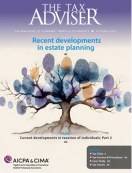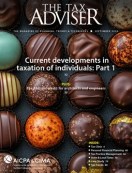This article looks at recent court decisions regarding S corporation shareholder reasonable compensation that provide helpful guidance on how an adviser can determine what is reasonable compensation.
S Corporation Income Taxation
Changing Level of Participation in an S Corporation for Tax Planning Purposes
A shareholder materially participates in an S corporation if the shareholder or the shareholder’s spouse is involved in the corporation’s trade or business on a regular, continuous, and substantial basis. This column discusses three tests that practitioners are likely to encounter when dealing with S corporation shareholders.
S Corporation Reasonable Compensation
A recent district court decision highlights the employment tax risks to S corporations that are found to have paid unreasonably low compensation to shareholder-employees while making distributions to the same individuals.
Distributing Property to S Corporation Shareholders
This item discusses the factors to consider for an S corporation distributing property to its shareholders.
Increased Opportunities for Sec. 338(h)(10) Elections
The Small Business Jobs Act changes the S corporation built-in gains (BIG) tax for tax years (and only for tax years) beginning in 2011. This article discusses the increased opportunities this affords buyers to elect to treat purchases of S corporation stock as asset purchases without triggering BIG tax.
Built-In Gains Recognition Period Temporarily Reduced for 2011 Transactions
The Small Business Jobs Act of 2010 includes an additional temporary reduction of the recognition period for built-in gains tax under Sec. 1374.
Classification of Business Entities That Are Not Corporations
An organization with two or more owners that is an entity separate from the owners and that is not a corporation is an eligible entity that can be classified as a corporation or a partnership. The regulations provide a set of default rules that establish the classification of an eligible entity if no classification election is made.
Increasing Passive Activity Loss Deductions with Self-Charged Interest
Generally, portfolio income cannot be used to offset passive activity losses, but there is a special rule for self-charged interest. This column examines the conditions under which such interest income is considered passive activity income.
S Corporations with Earnings and Profits
S corporations that have accumulated C corporation earnings and profits have both problems and opportunities. This article discusses the opportunities and explores solutions to the problems.
Elections Available to S Corporations with Significant Ownership Changes
This item examines why shareholders are typically motivated to request various S corporation elections and addresses why tax advisers should raise the question of the election at the time of ownership change and not at a later date.
Current Developments in S Corporations (Part II)
This article discusses S corporation eligibility, elections, and termination issues from the period July 2009–July 2010.
Current Developments in S Corporations (Part I)
This article discusses recent legislation, cases, rulings, regulations, and other developments in the S corporation area for the period July 9, 2009–July 9, 2010. This part focuses on various S corporation operating provisions.
QSubs Included in Definition of S Corp. for Purposes of Sec. 291(a)(3)
In Vainisi, the Seventh Circuit reversed a decision in which the Tax Court held that the 20% interest expense reduction imposed by Sec. 291(a)(3) would apply to a qualified subchapter S subsidiary (QSub) bank even for its tax years following the third year after it converted from C corporation to S corporation status.
S Corporations: Facing the 15% Sunset
One change with major implications for S corporations with prior C corporation earnings is the sunset of the 15% tax rate on qualified dividends. This favorable rate is due to expire on December 31, 2010.
Planning to Escape the S Corporation Built-in Gains Tax in 2010
The American Recovery and Reinvestment Act of 2009 suspended imposition of the built-in gains (BIG) tax for tax years beginning in 2009 and 2010 for qualifying S corporations.
Sec. 465 Traps for the Unsuspecting S Corporation Shareholder
Without proper planning, the at-risk rules set out in Sec. 465 can limit the amount of deductible S corporation losses.
The Story of Basis
Basis is a beneficial concept for a taxpayer—it shields the taxpayer from tax on the sale of an asset and can produce losses that reduce tax liability. It has been described as a “summary of the tax impact of [past] events” that have affected an asset. Nevertheless, basis can be elusive: It can appear or disappear when we are not paying attention. It can cling to an asset, be adjusted up or down, replicate itself, or shift to another asset. In other words, the summary that basis provides can have a number of potential twists and turns.
S Corp. Shareholder Basis for Circular or Certain Back-to-Back Loans
Practitioners advising on proper methods to use for shareholders to acquire basis in loans made to S corporations incurring losses can take away several points from recent court decisions.
S Corporation Basis Reductions for Nondeductible Expenses
When an S corporation has losses and deductions in excess of basis, some of which are nondeductible, noncapital expenses, will there be a carryover of the nondeductible items for purposes of reducing basis in a future year?
Consequences of S Corporation Termination in a Reorganization
An S corporation can participate as a corporate entity in a corporate reorganization; this leads to a substantive advantage of S corporations over partnerships
TAX PRACTICE MANAGEMENT
2025 tax software survey
AICPA members in tax practice assess how their return preparation software performed during tax season and offer insights into their procedures.














